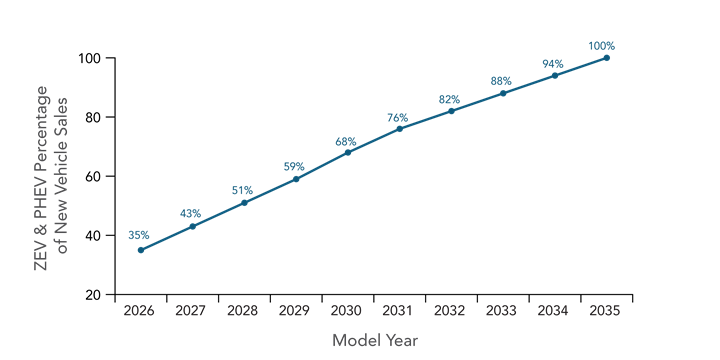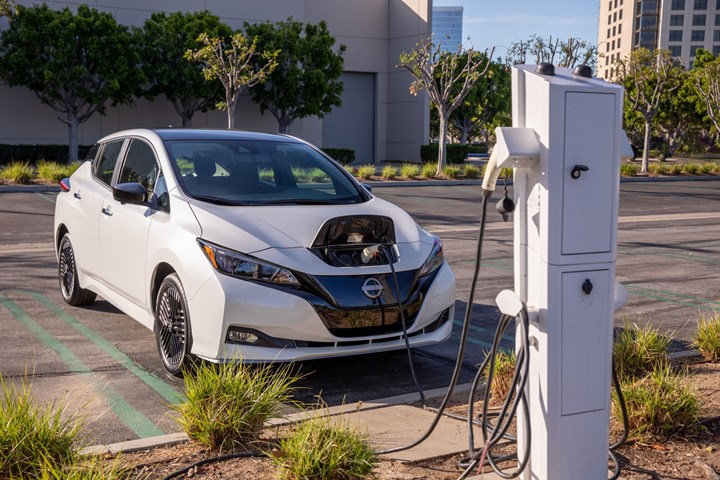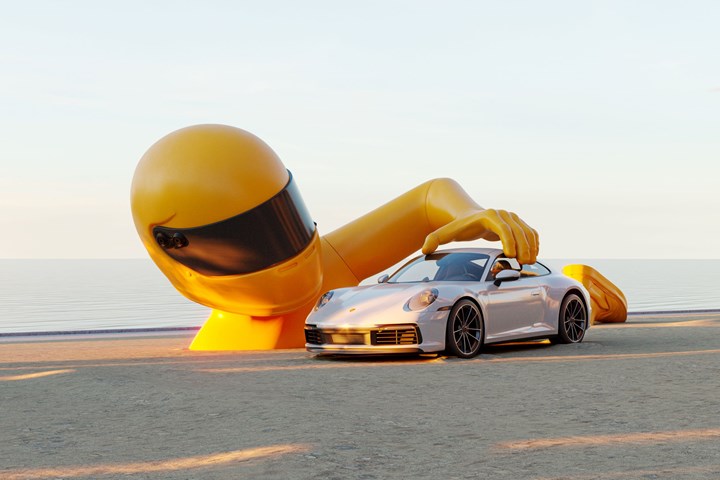on Audi in Dakar, EVs in Europe & California, Other Auto Developments
Audi is bringing renewable fuel to Dakar. . .where will Euro EVs be made. . .a car from the Czech Republic. . .CARB is investing plenty in EVs. . .the IRA and EV sales. . .VW Jetta GLI. . .U.K. truck driver shortage. . .art with cars. . .
Audi Bringing Renewable Fuel to Dakar Rally

Audi is running its innovative hybrids at Dakar with renewable fuel. Hard to imagine how any kind of vehicle would last more than a few minutes under those conditions. (Image: Audi)
Audi, like other global automakers, reckons that by 2025 some 40% of its sales will be pure electric vehicle or plug-in hybrids. And like other OEMs it is testing the tech to assure that the performance delivered is the performance that customers expect.
Like other—mainly European—OEMs, Audi is looking at the ways to reduce carbon emissions through the use of renewable fuels in combustion engine applications, too.
And to make sure that this fuel performs as it should, Audi will be putting it to an extreme test starting in late December through mid-January, as it will be filling the tanks of its three RS Q e-tron E2 desert prototypes with fuel that consists of 80% sustainable components, biomass based on residues that don’t compete with foodstuffs, and running them in the Dakar Rally.
Lower Carbon
“With this fuel mixture,” says Dr. Fabian Titus, Application and Thermodynamics Development at Audi, “the Audi RS Q e-tron saves more than 60% in carbon dioxide emissions.”
It should be noted that the racing sanctioning bodies, the FIA and ASO, have specific fuel regulations that must be met.
One interesting aspect of what Audi calls “reFuel” is that it provides a slightly higher engine efficiency than is obtained with conventional fuel. . .but the oxygen content of the fuel is lower than gasoline, which reduces the energy density, which means that there needs to be a larger fuel tank volume than would typically be the case. (Fuel flow meters on the participating vehicles assure there is no advantage of the additional on-board fuel for the Audis.)
The RS Q e-tron raced in the 2022 Dakar Rally held earlier this year and comported itself beyond expectations, coming in ninth.
For the RS Q e-tron E2s they have made modifications primarily to the vehicle exterior for aero improvements.
About the Vehicle. . .
It has an interesting powertrain setup:
- Each axle has a motor that Audi uses for its Formula E race cars. This provides a total system output of under 288 kW (the maximum drive power permitted by the Rally rules).
- There is a 2.0-liter four-cylinder turbocharged engine that Audi uses in its DTM race vehicles that is coupled to a generator, which the company also deploys in its Formula E cars.
- The engine charges the high-voltage, 52-kWh battery system that is then used to power the motors that power the wheels. In other words, a series hybrid.
The route of the 2023 Dakar will cross Saudi Arabia, going from the Red Sea to the Arabian Gulf in Dammam. As the picture above indicates: there’s a lot of sand to be traversed.
Comment: Yes, there is certainly an aggressive transition to EVs being undertaken by automakers. But let’s face it: ICE-powered vehicles aren’t going to suddenly go away. So gasoline of some sort will be required for some time to come. And while e-fuels may be expensive and not particularly efficient to produce, keep in mind that about 10 years ago the price of a kWh from a lithium-ion battery was on the order of $1,200, so that didn’t seem particularly reasonable.
///
Building BEVs in Europe

The ë-C4 X Electric is a new offer in the Citroën lineup. It is being manufactured in. . . Spain. (Image: Citroën)
In the first nine months of 2022 there were 1,002,720 battery electric vehicles (BEVs) registered in Europe. During the same period there were 583,245 BEVs registered in the U.S. Those numbers from Inovev.
The EV commitment in Europe is a very real thing and the number of vehicles that are produced there will grow in the near future.
Which brings us to a quiz:
Where will the greatest number of BEVs be manufactured in western Europe by 2030?
- Germany
- France
- Spain
The answer, according to Inovev, is Spain.
It calculates there could be 1.5-million BEVs built in Spain by 2030.
In Germany, 1.3 million. And France, 0.8 million.
OEMs that have announced Spanish BEV production include Stellantis, VW, Mercedes, and Ford, everything from passenger cars to light commercial vehicles.
///
A Hypercar from the Czech Republic

The Praga Bohemia. A supercar from the place it is named after. (Image: Praga)
“Praga is the biggest and oldest car brand you might not have heard of.”
Which is not the sort of thing you normally see in a press release. At least the “might not” mollifies things a bit.
A Bit of Background
Praga, based in the Czech Republic, produced its first car in 1907, having previously produced a variety of things, from bridges to steam trains.
When it got full-on in the transportation space, Praga manufactured motorcycles, commercial vehicles and aircraft, in addition to cars.
Post-World War II, the Communist government in Czechoslovakia told Praga it was in the truck and transmission business.
In 1989, with the fall of the Communist government, Praga continued with trucks and transmissions, but added motorcycles, racing karts and performed aircraft engine testing programs. It produces as many as 7,000 kart chassis per year.
Race cars were added to the portfolio in 2012.
That Was Then, This Is. . .
Now it has announced the Praga Bohemia, a composite-intensive race car that will go into limited production in the second half of 2023.
Limited as in 10 cars next year. Twenty per annum subsequently.
Total build: 89.
The Bohemias will be hand-built at the facility of Kresta Racing in the Czech Republic.
The vehicle is priced at $1.31-million.
The Bohemia was designed and engineered by Praga.
The engine is sourced from Nissan—the 3.8-liter, twin-turbo V6 that’s used in the GT-R. It is modified for Praga by Litchfield Engineering, such as swapping out the turbos and converting the engine to dry sump.
The engine is expected to produce 690 hp @ 6,800 rpm and 534 lb-ft of torque from 3,000 to 6,000 rpm.
The company focused on weight. The target is 2,164 pounds.
To achieve it, for example, 56 carbon fiber parts were designed for the interior. The target weight for the interior: 74.9 pounds. Although the car seems as though it is just for the track, the company says it can be driven to a track (there is air conditioning, as well as bespoke luggage that can be fitted into pods designed into the side of the Bohemia because, well. . .), then a helmet doffed and. . . .
Top speed: 186 mph.
Observation: The industry has a lot of heritage brands that could make a comeback using manufacturing techniques like carbon-fiber lay-up, which is far less tooling-intensive than metals. And plenty of low-volume components can be produced with additive manufacturing. (Yes, “plenty” and “low-volume” may seem to cancel one another out, but compared to alternative subtractive methods, additive comes out on top for the types of parts that are needed for vehicles with build volumes on the order of 89.) Of course, this can add up to exotic pricing.
///
Serious Money for Going EV

This is how California intends for things to go. (Image: CARB)
Some people still wonder about the viability of the transition to electric vehicles.
Some recent numbers from California—which, before you do an eye-roll, realize represents approximately 12% of all new passenger vehicle sales in the U.S.—underscore the reality of the transition. . .
Like $2.6 billion
That’s what the California Air Resources Board is investing in “clean” cars, trucks and mobility options.
While $381 million will be spent on clean transportation equity projects—like up to $15,000 in incentives for low-income consumers buying a new EV and $19,500 if they scrap an older vehicle as part of that transaction--$2.2 billion will be dispersed:
- >$2 billion for vehicles including school buses, transit buses and drayage trucks
- $33 million for small truck fleets transitioning to cleaner tech
- $135 million for demo and pilot projects
Another number:
$10 billion
That’s the amount that California is spending (including that $2.6 billion) to work toward the decarbonization of its transportation sector.
Also:
2035
The year that the state expects to have 100% of new car and medium truck sales be electric.
And:
2045
The year that new heavy-duty trucks are to be zero emissions.
One more:
40
The following states have adopted California’s vehicle standards under Section 177 of the Federal Clean Air Act:
- New York
- Massachusetts
- Vermont
- Maine
- Pennsylvania
- Connecticut
- Rhode Island
- Washington
- Oregon
- New Jersey
- Maryland
- Delaware
- Colorado
- Minnesota
All-in, these states and California account for about 40% of all new vehicle sales in the U.S. Although they haven’t all signed on for California’s 2035 and 2045 rules, this is group is an important part of the total market.
This is not to say that internal combustion engines are going away (as previously mentioned in the Audi piece above).
But if you’re investing in future capacity, ICEs are probably not the place to spend a whole lot doing it.
///
What the IRA Could Mean to EV Sales

The Nissan Leaf EV is built in Tennessee—which is a plu$ for IRA qualification. (Image: Nissan)
While on the subject of dollars and electric vehicles. . .
The Inflation Reduction Act (IRA) of 2022 is the law that includes adjusted figures for electric vehicle tax credits as well as new sourcing requirements relative to EVs.
For example, starting next year there is a $7,500 tax credit available for the purchase of an EV if. . .
- The vehicle is assembled in North America
- At least 40% of the critical minerals in the battery are sourced (new mining, processing, recycling) in the U.S. or a country with which the U.S. has a free-trade agreement
- At least 50% of the battery components are made or assembled in the U.S. or a country with which the U.S. has a free-trade agreement
- The car, hatch or wagon costs $55,000 or less
- The SUV or truck costs $80,000 or less
- A single tax filer’s adjusted gross income is $150,000 or less; a head of household filer is at no more than $225,000, and a joint filer earns no more than $300,000
Seemingly there are more moving parts in those figures than there are in an EV powertrain (and we haven’t even mentioned the annual changes that will occur vis-à-vis mineral and battery component content).
Who Knows How Much?
Cox Automotive analysts were interested in knowing what consumers know of and think about the IRA as it relates to EVs (there are plenty of other items in the act, ranging from prescription drug prices to IRS enforcement).
So it conducted a survey in September (the act was signed in mid-August) among 1,000 consumers.
And one of the least remarkable findings of all time is that 32% said they are “somewhat familiar” with the EV tax credit elements of the IRA. (Let’s face it: “somewhat” is a fairly wide-ranging adjective, something that almost anyone in good conscious could probably say even if they only know that there are EV tax credits involved.)
Fifteen percent say “extremely familiar” and 16% “very familiar,” or a total of 63% in the familiarity camp. (Heck, I wrote those bullet points above and I don’t consider myself to be familiar with what’s what.)
On the other side, 14% are “not at all familiar” and 23% are “not very familiar,” so there are 37% who are to some extent in the dark.
Which means dealers and OEMs, in particular, have a lot of educational work ahead of them—on top of explaining what things like MPGe and DC fast-charging are.
But apparently the IRA is going to make more people inclined to go EV.
Looks Like They’ll Buy
Twenty-two percent “strongly agree” and 28% “somewhat agree” that receiving a tax credit would encourage them to buy an EV.
On the other side, 17% “strongly disagree” and 8% “somewhat disagree.”
So there is 25 point delta to the “agree” advantage.
(And yes, 25% “neither agree nor disagree.”)
Economic Advantage
For those who are interested in what used to be called “industrial policy,” there is a notable finding from Cox.
When asked whether they agree with “The EV tax credit will be good for the economy”
- 22% strongly agree
- 30% somewhat agree
- 28% neither agree nor disagree
- 8% somewhat agree
- 12% strongly disagree
So assuming they can get that tax credit figured out, there will be more customers for EVs as a result of the IRA and the economy will be better for it.
///
2022 Volkswagen Jetta GLI 2.0T Autobahn

The VW hot hatch sedan: Jetta GLI. (Image: VW)
Were you to drive from the Hannover Airport to Wolfsburg, it would take about an hour. Were you to take the train, if you managed to get on one of the high-speed ICE* trains, it would require about the same amount of time. Were you to have to take the more conventional trains with connections, you’re looking at about an hour 26.
Of course, the A2 between the two cities let’s you go fast. . .but then there are potential traffic jams that you could encounter, which wouldn’t likely be the case on the Deutsche Bahn.
That said, there is something about German car culture that says you want to drive. Sehr schnell.
Of course, not everyone in Germany is able to afford the sorts of sedans that many German managers get as part of their compensation package. Walk around the center city areas of many German cities and you’ll see cars parked in areas that seem incapable of accommodating what’s there.
The point of all of this being that (1) as there are more than 8,000 miles of Autobahn in Germany, there is undoubtedly an intrinsic notion of driving fast that are part of all engineers there and (2) there is a market for affordable sedans.
Which brings me to the Volkswagen Jetta GLI 2.0T Autobahn, a compact sedan with more than styling that gives it some pep.
Although the car is built in Puebla, Mexico, not Wolfsburg, it still strikes me as something that would be credible where the streets have no speed limits.
And it is worth knowing that the six-speed manual gearbox is from Germany.
(Digression: While driving the Jetta I found myself at a traffic signal behind a VW ID.4. And it occurred to me that there really is a vast electromechanical chasm between the electric vehicle and one that requires the synchronization of the driver’s right arm and both feet. It is almost as though I would be writing this on a typewriter keyboard rather than a Dell. The result would be the same but achieving it would be entirely different.)
Red Means Fast?
Presumably the answer is yes.
The GLI has a gloss black honeycomb grille with a red stripe sandwiched between two thin chrome elements stretching from projector LED headlamp to headlamp.
The gloss interior trim has a wood-like pattern that includes. . red.
The perforated black leather seating surface has a red underlay. The contrast stitching for the interior trim—red.
The car I happened to drive had the $395 optional paint package in. . .Kings Red Metallic.
The point being, this is not a vehicle for those who are interested in blending in to the environment.
The GLI is powered by a 2.0-liter turbocharged four that produces 228 hp and 258 lb-ft of torque. As mentioned, I drove the six-speed manual; there is an optional seven-speed dual-clutch automatic.
(While the stainless steel pedal caps and footrest provide that look of technicality that cars of this nature should have, I did find that after walking through some snow to get to the car and then driving, the pedals were a bit more slippery underfoot than would have been appreciated.)
As this is the performance version, there are elements like an electronically controlled front limited slip differential (VAQ), which senses vehicle and wheel speed, yaw and lateral g-forces, such that it transfers torque between the front wheels as needed.
There is an adaptive damping system (DCC) that individually adjusts the shock rates depending on conditions and drive mode (Comfort, Eco, Sport, Custom).
Quick stuff.
Electric Tech, Too
Of course there are an 8-inch screen and wireless charging and Apple CarPlay and Android Auto and USB-C ports and a 10.25-inch digital gauge cluster (which happens to have plenty of red.)
Blind spot monitor. . .rear traffic alert. . .adaptive cruise. . .lane keeping assist. . .automatic high-beam control. . .and various other safety-enhancing amenities are part of the package.
Consider
The number of sedans with a price point just north of $30K (MSRP for this: $31,295) that have a performance orientation is small. And getting smaller.
If this is your kind of car, you’d better not wait.
*In this context, “ICE” doesn’t stand for “internal combustion engine” but “Intercity Express.”
///
How to Solve the Truck Driver Shortage (Maybe)

The U.K. has a truck driver shortage. What are the solutions? (Image: IAM RoadSmart)
The U.K., like other places in the world (including the U.S.), is dealing with a shortage of commercial truck drivers.
According to its Office for National Statistics Labour Force Survey, the number of what are called “large goods vehicle” drivers fell in the U.K. by 30,300 in the first quarter of 2022, an 11% decrease from June 2021.
What’s more, the age of existing drivers is increasing, with 29% of them being older than age 56 (between July 2020 and July 2021). During the same period, the Office for National Statistics found that 19% of the overall employed population were the same age. Retirement age in the U.K. is 66. So the number of drivers who will retire will measurably outpace those in other occupations.
Autonomy or. . . .
While there is an increased amount of attention and resources being applied to develop autonomous trucks to transport goods in the U.S., a U.K. government consultation has come up with a rather, um, low-tech approach:
Allowing drivers as young as 18 who have just passed their practical driving test, which qualifies them for a category B car license, a boost to a C1 license, which allows driving vehicles that weigh up to 7.5 tonnes.
Said another way: people who get a license that allows them to drive a vehicle that has no more than eight passenger seats would suddenly be able to drive medium-sized trucks.
Not surprisingly, not everyone is chuffed with this idea.
“Research has revealed that larger vehicles pose a higher risk to other road users, so it is critical that those who drive them possess the necessary skills and training to drive them safely,” said Neil Greig, Director of Policy and Research at IAM RoadSmart, which is part of the U.K.’s largest road safety charity, the Institute of Advanced Motorists.
Greig has a reasonable low-tech recommendation:
“To combat the truck driver shortage, we would support steps to expand driver testing capacity, making the industry more attractive to a more diverse workforce and improving the working conditions and infrastructure for drivers. This way, we can ensure that the nation’s truckers continue to deliver vital goods, without compromising the safety of other road users.”
Hmm. . .make it more appealing and maybe you’ll get more qualified people to do the job.
Not as sexy a solution as autonomous tech, but probably quite effective.
///
Designing Dreams with Cars

Dream Big. on Miami Beach. (Image: Porsche)
“In the end, I like a ridiculous idea that’s really well crafted.”
That’s self-described “image maker” Chris Labrooy. He’s the artist who created that installation, “Dream Big.”*
Labrooy had imagined, when young, that he’d become a car designer.
He attended the Royal College of Art in London. He obtained an MA in Design Products.
But Labrooy’s career took a different path, as he became interested in what he could do with computer-generated imagery.
While he isn’t designing cars for an OEM, the Aberdeenshire, Scotland-based Labrooy includes Porsche, Jaguar, Lamborghini, Citroen, and Lexus among his clients.
So in many respects, he is designing with cars.
(Labrooy has owned four Porsches; his current driver is a Cayman 718 GTS.)
Labrooy:
“Of all the consumer products cars are the ultimate objects of desire.”
And they lend themselves to some amusing art, as well.
*What you’re reading was published on December 1, 2022. If you can get to the beach of the Pérez Art Museum Miami by Saturday December 3, you can see “Dream Big.” IRL.
<><><>
RELATED CONTENT
-
FCA Opens the Door to The Future
FCA introduced a high-tech concept vehicle today, the Chrysler Portal, at the event previously known as the “Consumer Electronics Show,” now simply CES.
-
GM Develops a New Electrical Platform
GM engineers create a better electrical architecture that can handle the ever-increasing needs of vehicle systems
-
Apple Reports its First Fender-Bender with Autonomous Car
Apple Inc. reports that one of its self-driving cars operating in autonomous mode was struck by another vehicle while inching into freeway traffic in California.


.jpg;width=70;height=70;mode=crop)






